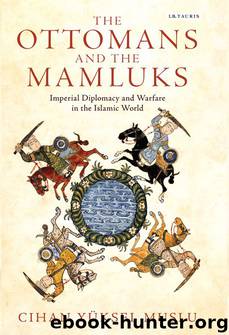Ottomans and the Mamluks, The: Imperial Diplomacy and Warfare in the Islamic World (Library of Ottoman Studies) by Cihan Yüksel Muslu

Author:Cihan Yüksel Muslu [Muslu, Cihan Yüksel]
Language: eng
Format: azw3
ISBN: 9780857735805
Publisher: I.B.Tauris
Published: 2014-07-25T04:00:00+00:00
The Last Performances of the Mamluk Court for Bayezid
Five days after his audience with the Ottoman ambassador, Qansuh al-Ghawri called the European consuls in Mamluk lands to a public meeting where he confronted them about their waning loyalty. In the presence of these consuls and his own administrators, he announced that the Mamluk governor of al-Bira had captured some of Shah Isma‘il’s messengers,80 and that the letters they were carrying at the time invited the sovereigns of these European consuls to an alliance against the Ottomans and Mamluks. The fact that the Mamluk sultan publicly reprimanded this group only five days after the Ottoman ambassador’s audience with the Mamluk sultan could not have been a coincidence; Qansuh al-Ghawri probably designed this public occasion to impress the Ottoman ambassador and may have even consulted him about the situation.81 These European consuls, which Ibn Iyas generically called the “Franks,” included a representative from Venice, where Bayezid had conducted a long and successful war nine years earlier.82 At this critical moment in 1511, the entire political world seemed to revolve around the Ottomans and the Mamluks.
While this particular collaboration raises the question of whether Bayezid aided the Mamluks merely out of his concern for his son, the first Ottoman maritime aid had already reached Mamluk lands before the eruption of Prince Korkud’s case. In September 1507 (two years before Korkud’s appearance in Damietta), Kemal Reis had brought a small Ottoman fleet to Alexandria.83 Moreover, Ibn Iyas also mentioned that Yunus al-‘Adili—Qansuh al-Ghawri’s ambassador to Bayezid in 1510–11—had also offered to pay for Ottoman aid. Bayezid, however, refused any payment and provided the needed materials free of charge.84 By generously contributing to the defense of the Holy Cities, Bayezid may have also been seizing an opportunity to break the Mamluk monopoly in the leadership of the Sunni Muslim world. In short, while Bayezid would have sent help in any case, his aid might normally have cost the Mamluk sultan either an economic or a political concession. The presence of Korkud in Mamluk lands and Qansuh al-Ghawri’s intense efforts on his behalf possibly diminished this cost.
The last known letters between the Ottomans and the Mamluks during Bayezid’s reign were exchanged between Khayr Bey, the Mamluk governor of Aleppo, and the Grand Vizier Hadım Ali Paşa or his successor Hersekzade Ahmed Paşa. In a letter dated June 4, 1511 that specifically addressed the Ottoman grand vizier, Khayr Bey raised the possibility of an alliance between Bayezid and Qansuh al-Ghawri against the Safavids.85
In June–July 1512, one year after Khayr Bey’s letter, the Mamluk sultan Qansuh al-Ghawri hosted 14 ambassadors in Cairo.86 Their missions reflected a wide geographical range from the Venetians to the Hafsids to the Ottomans, and this impressive congregation asserted the lasting centrality of the Mamluk imperial capital in world events.87 The primary purpose of the Ottoman mission, however, was to inform the Mamluk sultan about the accession of Bayezid’s son Selim, which had taken place in April 1512. A few days after receiving this news, Qansuh al-Ghawri learned that his friend and foe Bayezid had passed away.
Download
This site does not store any files on its server. We only index and link to content provided by other sites. Please contact the content providers to delete copyright contents if any and email us, we'll remove relevant links or contents immediately.
| Africa | Americas |
| Arctic & Antarctica | Asia |
| Australia & Oceania | Europe |
| Middle East | Russia |
| United States | World |
| Ancient Civilizations | Military |
| Historical Study & Educational Resources |
Empire of the Sikhs by Patwant Singh(22767)
The Wind in My Hair by Masih Alinejad(4843)
The Templars by Dan Jones(4558)
Rise and Kill First by Ronen Bergman(4545)
The Rape of Nanking by Iris Chang(4023)
12 Strong by Doug Stanton(3419)
Blood and Sand by Alex Von Tunzelmann(3055)
The History of Jihad: From Muhammad to ISIS by Spencer Robert(2505)
Babylon's Ark by Lawrence Anthony(2431)
The Turkish Psychedelic Explosion by Daniel Spicer(2245)
Gideon's Spies: The Secret History of the Mossad by Gordon Thomas(2235)
No Room for Small Dreams by Shimon Peres(2235)
Inside the Middle East by Avi Melamed(2230)
Arabs by Eugene Rogan(2193)
The First Muslim The Story of Muhammad by Lesley Hazleton(2154)
Bus on Jaffa Road by Mike Kelly(2035)
Come, Tell Me How You Live by Mallowan Agatha Christie(2026)
Kabul 1841-42: Battle Story by Edmund Yorke(1921)
1453 by Roger Crowley(1880)
